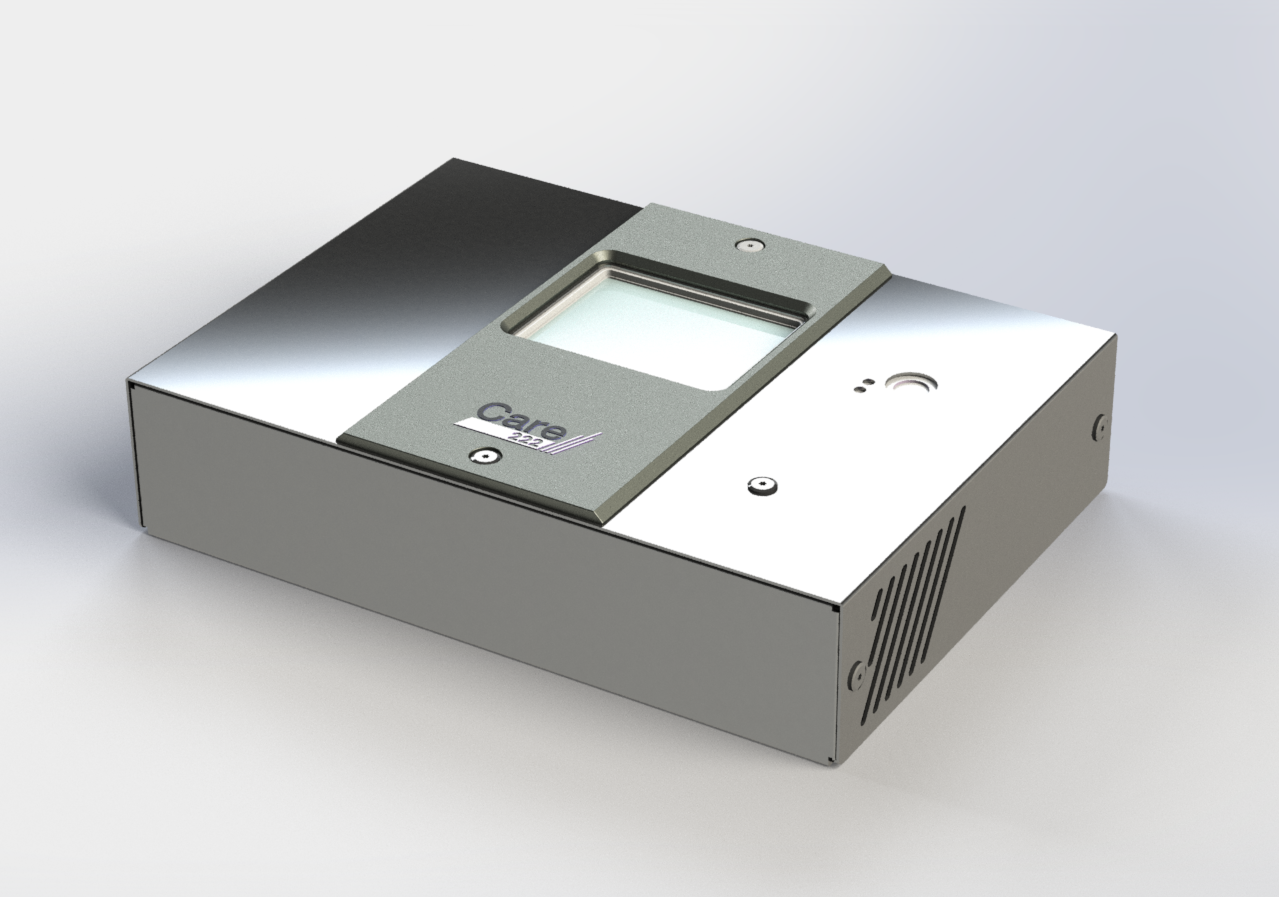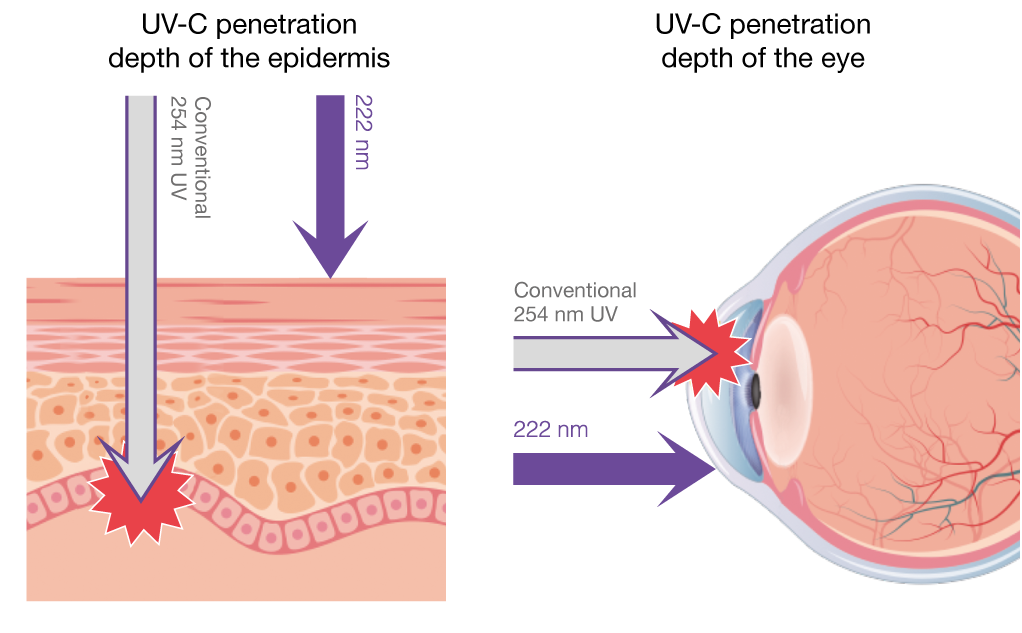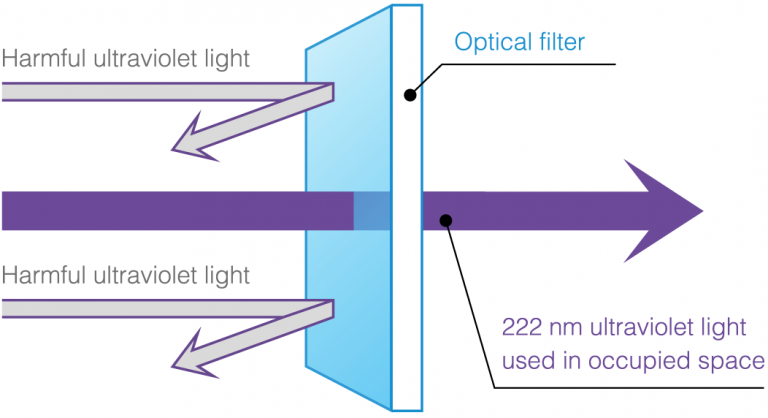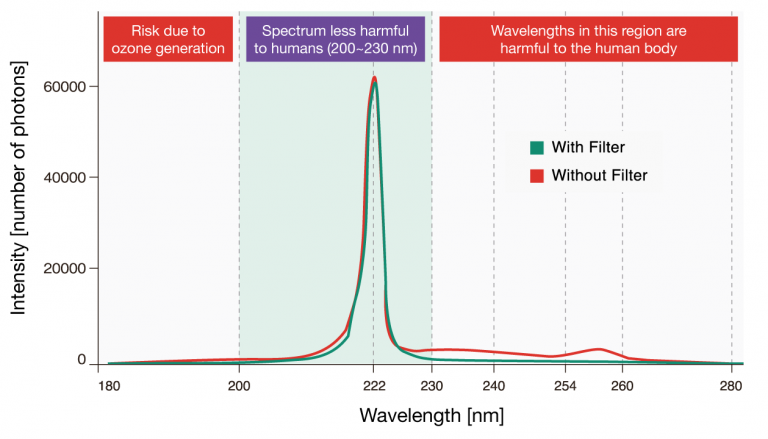Ushio Care222®
Filtered Far UV-C Disinfection Technology
Navigate your way through the Care222® line
An introduction to Ushio’s Care222® far UV-C disinfection lamps
Ushio is proud to introduce the Care222® series, a new line of krypton chloride (KrCl) excimer lamps designed for highly-effective microbial reduction. The Care222® line uses ultraviolet germicidal irradiation (UVGI) to kill bacteria and inactivate a vast range of viruses. UVGI is commonly known as UV disinfection. The system has already been deployed in many unoccupied spaces. With recently completed and ongoing studies taking place, new safe ways are emerging to make Care222® products your best opportunity to secure microbial reduction in occupied spaces too.
Ushio’s longstanding collaborations with respected scientific institutions, such as Kobe University of Japan and the University Hospital of Singapore, have contributed to the development of Care222® technology. The 222 nm irradiation kills bacteria and inactivates viruses without damaging human cells/tissues using narrow-band spectrum UV. Ushio has been granted exclusive use of new patented band-pass wavelength filtration technology. The system has demonstrated its ability to inactivate all kinds of ‘super bugs’ such as MRSA, influenza, MERS-CoV, as well as viruses like Ebola.
In September 2020, the Department of Infectious Diseases at Hiroshima University Hospital confirmed that Care222® lamps are effective against SARS-CoV-2, the virus responsible for the COVID-19 pandemic.
Which Care222® model is for you?
For original equipment manufacturers (OEMs), Ushio is able to supply the Care222® B1 lamp and power supply component to be integrated into your own devices. This is of particular interest to manufacturers of medical lighting equipment, sanitary equipment such as hand dryers, cleanliness-sensitive production lines, and more.
The Care222® U3 device includes a full housing, power supply, and power source connection. Designed to be mounted on a ceiling, hung from a pole or stand, the Care222® U3 unit has three activation settings. These are continuous output, simple on/off switch duty control, or activation through the built-in human sensor.

Care222® Model B1 Specifications
- Light Source: Mercury-free krypton chloride (KrCl) excimer lamp
- Emitted Wavelength Range: 200 nm ~ 230 nm
- Peak Wavelength: 222 nm Far UV-C
- Output: 5.4 mW/cm2 (20 mm from the window)
- Input Voltage: DC 24 V
- Power Consumption: 12 W
- Cooling Fan: N/A
- Weight: 177 g
- Dimensions: 92 mm x 75 mm x 19 mm
- Activation Mode: N/A

Care222® Model U3 Specifications
- Light Source: Mercury-free krypton chloride (KrCl) excimer lamp
- Emitted Wavelength Range: 200 nm ~ 230 nm
- Peak Wavelength: 222 nm Far UV-C
- Output: 5.4 mW/cm2 (20 mm from the window)
- Input Voltage: DC 24 V (Possible to use AC 100 V – 240 V with adapter)
- Power Consumption: 15 W
- Cooling Fan: Included
- Weight: 1 kg (without AC adapter)
- Dimensions: 205 mm x 150 mm x 50 mm
- Activation Mode: On/Off, Continuous, Human Sensor
What is Ultraviolet Germicidal Irradiation (UVGI)?
UV radiation between 160 nm and 310 nm has a unique germicidal ability to act as an effective means of disinfection. UVGI achieves this by disrupting the DNA functions of microorganisms and pathogens such as bacteria, viruses, and protozoa. This has a mutagenic effect on organisms by exciting the molecules at the core of their DNA and RNA. The catastrophic destruction of their genetic structure renders the pathogenic organisms unable to reproduce or infect and, in some cases, kills them.
Able to neutralise living cells in a matter of seconds, UVGI is an ideal alternative to chemical disinfection. The use of chemicals is detrimental to the environment, and in most cases, can lose effectiveness over time due to the ability of microorganisms to develop a resistance to them. There is no living cell with a total resistance to ultraviolet light, it occurs naturally within the environment, and does not affect the taste or smell of the UVGI treated substance.
The difference between disinfection and sterilisation
Disinfection and sterilisation are both methods which seek to achieve decontamination through the removal of pathogens. While many people regard these terms to be interchangeable, they actually have slightly different meanings pertaining to the level of cleanliness achieved.
The definition of disinfection
Disinfection is a process in which the number of pathogenic microorganisms, such as viruses and bacteria, is reduced through inactivation. Disinfection is ineffective against bacterial endospores despite being able to remove pathogens, which is what separates this type of cleaning from sterilisation.
Various methods of disinfection are commonly used throughout daily life, mostly for the acceptable decontamination of surfaces and air. In a hospital scenario, low-level disinfection is implemented on non-critical surfaces and equipment which come into contact with intact skin, such as bed frames or the inflatable cuff of a blood pressure monitor. High-level disinfection must be implemented on semi-critical equipment which comes into direct contact with mucous membranes or non-intact skin; this includes devices such as endoscopes and respiratory therapy equipment.
The definition of sterilisation
Sterilisation is a process in which all pathogenic microorganisms, including vegetative endospores, are completely destroyed. Sterilisation kills, eradicates, and / or inactivates biological lifeforms such as bacteria, fungi, viruses, endospores, and prions.
Within healthcare practices, equipment sterilisation is a mandatory process which must take place before every use. Critical medical and surgical devices enter parts of the body tissue which are usually sterile or pertain to the flow of sterile bodily fluids, such as blood and urine.
Filtered 200–230 nm far UV-C wavelengths offer protection and disinfection
Generally, ultraviolet light has the deserved reputation of being harmful to humans. Beyond 230 nm, UV light has enough intensity that it is able to penetrate the epidermal layer of skin and cause molecular changes in the layers beneath. UV wavelengths between 200 nm and 230 nm are unable to transmit through the top layer of skin and simply inactivate any bacteria or viruses that may be present on the surface.
Care222® devices emit far UV-C wavelengths in the 200–230 nm band, with a peak at 222 nm. This band is mostly absorbed by proteins in the skin, which is why it does not transmitted beyond the top layer (stratum corneum), nor that of the cornea in the eye; therefore, molecular mutation of the deeper skin formation layer, the stratum spinosum, can be avoided. By contrast, the wavelengths emitted by conventional 254 nm UV disinfection lamps do penetrate the deeper tissue layers and can cause mutations that lead to serious illnesses, such as skin cancer or cataracts.

Care222® filters out dangerous UV-C rays and prevents ozone production
Ushio is very keen to stress that unfiltered excimer discharge lamps are not mono-spectral. This means that although Care222® has a peak wavelength of 222 nm, wavelengths between 200 nm and 320 nm are also emitted at various intensities. For this reason, Ushio has worked with research partners from around the world to develop an optical band-pass filter which prevents harmful UV-C rays from leaving the lamp. This patented filter has been exclusively licensed to Ushio.

With that said, Ushio would like to issue a very serious warning. There are many companies and groups advocating the use of UV-C disinfection, but they do so without stressing the serious nature of this band of radiation. Without the crucial optical band-pass filter, even Ushio’s 222 nm technology would be harmful to humans. It is important that you question your UV-C disinfection lamp supplier very carefully. If they simply tell you that 222 nm is safe and their lamp does not emit any other wavelength – walk away and find a supplier that knows what they are talking about. Failure to do so could put you in a situation that risks damage to the health of anyone who is exposed to unfiltered UV radiation.

Ideal applications for the Care222® series
- Conference rooms
- Elevators
- Educational establishments (schools, universities, etc.)
- Food and beverage production
- Hospitals
- Hotels
- Industrial kitchens
- Laboratories and clean rooms
- Meat production/processing
- Public spaces
- Public transport
- Sanitary facilities (toilets, changing rooms, etc.)
- Surgical practices and cleanliness-sensitive areas
- Other general surface disinfection applications
Care222® product enquiry contact form
By filling in this contact form, you will help Ushio to respond to your queries as fast as possible. It will save time, because these are common questions that we will need to ask you anyway, in order to provide the best service and solutions.
Once the form is submitted, your answers will make their way directly to our 222 nm excimer experts. Responsibility for contacting you will then be assigned to the member of our team with the right knowledge and background to bring the best solution to your business.

